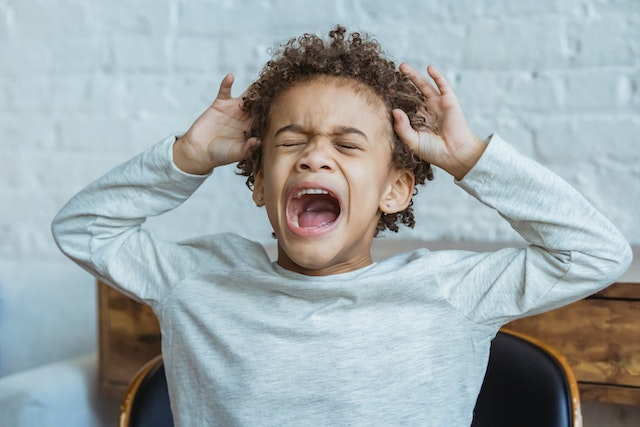Are you concerned about the increasing prevalence of stress and anxiety in children?
Have you ever wondered what factors contribute to this trend?
Well, you’re not alone. Many parents and caregivers are noticing a rise in stress and anxiety levels among children and are looking for ways to address it.
In today’s world, children face a variety of stressors that can impact their mental health. From academic pressure to social media exposure, there are many factors that can contribute to anxiety in children. According to research, stress and anxiety are the most common mental health problems experienced by children and teenagers. In this blog post, we will explore some of the reasons why stress and anxiety are so common in children these days.
1. Academic Pressure
One of the main reasons for stress and anxiety in children is academic pressure. Children today face intense pressure to perform well academically. Parents, teachers, and society in general have high expectations of academic achievement, and children are pushed to excel in school from a young age. Research shows that 61% of high school students report feeling a lot of pressure to get good grades (American Psychological Association, 2014). An example of this can be seen in a study of high school students in South Korea, where academic pressure is famously intense. The study found that students who perceived higher academic pressure had a higher likelihood of experiencing anxiety and depression (Lee & Song, 2019).
Parents are overscheduling kids to make them excel in everything they pursue. This pressure can lead to stress and anxiety, as children feel the need to constantly perform at their best to meet these expectations. A study of elementary school children found that those who had less free playtime and more structured activities had higher levels of cortisol, a hormone associated with stress (Barker et al., 2014). Another study found that over-scheduling can lead to children feeling overwhelmed and stressed, which can increase their risk of developing anxiety and depression (Radesky et al., 2019).
Recommended reading: Is Your Child Getting Enough Play Time?
Recommended reading: 7 Tips to Balance Academic with Non Academic Activities
2. Technology and Social Media
Children are growing up in a digital age, where they are constantly exposed to social media and technology. Social media platforms like Facebook, Instagram, Snapchat, TikTok, and others have changed the way children interact with their peers, and it can have both positive and negative impacts on their mental health. Unfortunately, social media can also contribute to stress and anxiety in children.
Unrealistic expectations and standards:
Firstly, social media creates unrealistic expectations and standards that children feel they must live up to. For example, they may see perfect images of other children’s lives, such as luxurious vacations, fancy clothes, and extravagant birthday parties, which can make them feel like they are missing out or not living up to expectations. Research has shown that social media use is positively correlated with increased levels of anxiety and depression in children and adolescents (Twenge & Campbell, 2009).
Cyberbullying:
Secondly, social media can lead to cyberbullying, which can be a significant source of stress and anxiety in children. Cyberbullying is when someone uses social media or other digital communication methods to harass or bully another person. According to a study conducted by the National Center for Education Statistics, about 15% of students aged 12-18 reported being bullied online (Bauman, Toomey, & Walker, 2013). Cyberbullying can be more challenging to escape than traditional bullying, as children may feel like they are being attacked in their own homes, and the bullying can be pervasive, 24/7.
Fear of missing out:
Thirdly, social media can contribute to the fear of missing out (FOMO) in children. FOMO is the feeling that other people are doing exciting things without you, and it can be a significant source of stress and anxiety in children. For example, if a child sees their friends posting pictures of a party they were not invited to, they may feel left out, unwanted, and sad. According to a survey conducted by Common Sense Media, 3 in 4 teenagers in the US check social media before going to bed, and 41% of them say they feel anxious if they can’t access their social media accounts (Common Sense Media, 2019).
A study published in the Journal of Social and Clinical Psychology found that limiting social media use to 30 minutes a day can lead to significant reductions in depression and loneliness (Hunt et al., 2018).
3. Family Issues
Family issues can also contribute to stress and anxiety in children. Divorce, separation, financial problems, and other family issues can have a significant impact on a child’s mental health. Children may feel responsible for the problems in their family or feel anxious about their future due to the uncertainty caused by these issues.
Financial problems:
According to a study conducted by the National Survey of Children’s Health, children from families that experience financial hardship are at an increased risk of developing anxiety disorders. Financial problems can lead to a lack of stability and security in the home, which can cause children to feel anxious and worried about their future. Additionally, children who witness their parents arguing about money or struggling to make ends meet may internalize these conflicts and feel responsible for the family’s financial situation, which can lead to feelings of anxiety.
Divorce and separation:
Studies have found that children of divorced parents are at an increased risk of developing anxiety and other mental health problems. A study of children who experienced divorce found that they had a higher likelihood of experiencing symptoms of anxiety and depression (Kelly & Emery, 2003). The disruption of the family unit and changes in living arrangements can be stressful for children, and they may feel a sense of loss or uncertainty about the future. Moreover, conflict between parents during and after a divorce can create a toxic environment for children, leading to anxiety and other emotional problems.
Illness and Death:
Other family issues such as the illness of a family member or the death of a loved one can also cause anxiety in children. Children may struggle to understand and cope with these difficult situations, and they may feel overwhelmed by the emotions that arise from them.
Recommended reading: How To Explain Death To A Child
It is important for parents to be aware of the impact that family issues can have on their children’s mental health and to provide appropriate support and resources. This may include seeking counseling or therapy, engaging in open and honest communication with children about the issues, and maintaining a stable and predictable home environment as much as possible.
4. Peer Pressure
Peer pressure refers to the influence that children or adolescents experience from their peers or social group to conform to certain behaviors, attitudes, and beliefs. This can be positive or negative, depending on the nature of the behavior being influenced. Negative peer pressure can lead to anxiety in children, as they may feel the pressure to conform to behaviors or attitudes that they may not be comfortable with.
Substance abuse:
One of the most common forms of negative peer pressure is related to substance abuse. Children may feel pressure from their peers to smoke, drink, or try drugs, and they may fear being rejected or ostracized if they do not conform. Substance abuse can lead to significant anxiety and other mental health issues in children.
Social media:
Social media has become a significant source of peer pressure for children, with many feeling the need to conform to the expectations of their peers in terms of posting photos, engaging in certain online activities, and participating in online debates. Children may fear being left out or ridiculed if they do not conform to these expectations, leading to significant anxiety.
Recommended reading: How Can I Find Out What My Child Is Learning from Friends, School, and the Media?
Academic performance:
Peer pressure can also be related to academic performance, with children feeling the need to conform to the expectations of their peers in terms of grades, test scores, and other measures of academic achievement. Children may fear being ostracized or viewed as inferior if they do not meet these expectations, leading to anxiety and stress.
Appearance and body image:
Peer pressure related to appearance and body image is also common among children, with many feeling the need to conform to the expectations of their peers in terms of fashion, hairstyles, and body shape. Children may fear being rejected or viewed as unattractive if they do not conform, leading to anxiety and other mental health issues.
Recommended reading: 5 Things To Do When Your Child Says “I Am Fat!”
Bullying:
Bullying is another form of negative peer pressure that can lead to significant anxiety in children. Children may feel pressure from their peers to participate in bullying behaviors, or they may fear being bullied themselves if they do not conform. Bullying can have a significant impact on a child’s mental health and wellbeing, leading to anxiety, depression, and other mental health issues.
5. Lack of Sleep and Exercise
Finally, lack of sleep and exercise can also contribute to stress and anxiety in children. Many children today have busy schedules that leave little time for rest and relaxation. A lack of sleep and exercise can make children more susceptible to stress and anxiety, as their bodies and minds are not getting the rest and stimulation they need.
Sleep is essential for a child’s mental and physical health, and inadequate sleep can lead to a range of problems, including stress and anxiety. Research has shown that children who do not get enough sleep are more likely to experience symptoms of anxiety and depression. This may be due to the fact that sleep helps to regulate mood, and when a child is sleep-deprived, their mood may be more volatile and reactive.
Regular physical activity is important for maintaining good mental health, and children who are not active may be more vulnerable to stress and anxiety. Exercise helps to reduce stress and anxiety by releasing endorphins, which are natural mood-boosters. It also helps to reduce the levels of stress hormones such as cortisol in the body. Children who do not get enough exercise may have higher levels of stress hormones and may be more prone to anxiety.
For example, a study published in the Journal of Abnormal Child Psychology found that children who engaged in regular physical activity were less likely to experience symptoms of anxiety and depression than those who were not active. Similarly, research has shown that children who get enough sleep are better able to regulate their emotions and may be less vulnerable to stress and anxiety.
Recommended reading: Mindfulness Activities for Kids
Conclusion: Stress and Anxiety in Children
In conclusion, stress and anxiety are common mental health problems that affect children today. Factors such as academic pressure, technology and social media, family issues, peer pressure, and a lack of sleep and exercise can all contribute to stress and anxiety in children. It is important for parents, educators, and society as a whole to recognize the impact of these factors and work to address them to help children manage their stress and anxiety levels.




